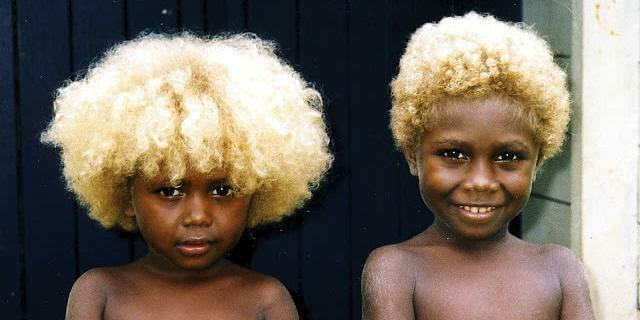Melanesians, the Black islanders with natural blond hair

In the heart of the South Pacific lies a group of islands home to one of the world’s most genetically unique populations—Melanesians. With presence in countries like Papua New Guinea, the Solomon Islands, Vanuatu, and Fiji, these dark skinned islanders stand out for a striking reason, around 10% of them are born with blond hair and less than 1% with blue eyes.
This rare combination defies the common expectations about race and appearance, offering a fascinating insight into human genetics and the diversity of the human experience. At first glance, many assume this unique look must be the result of colonial intermixing or foreign ancestry. But that couldn’t be further from the truth.
Melanesians, especially those from places like the Solomon Islands and Vanuatu, have carried these traits for generations, long before European ships arrived on their shores. In fact, the genes responsible for these features are completely indigenous to their region.
The blond hair mystery
A 2012 study revealed by researchers discovered that the naturally blond hair in some Melanesians, particularly in the Solomon Islands, comes from a gene called TYRP1—completely different from the gene that causes blond hair in Europeans. Thus indicating that Melanesians and Europeans evolved the same trait independently, a rare and fascinating phenomenon known as convergent evolution.
However, since race is typically defined by rigid categories and assumptions, people with dark skin and blond hair are sometimes met with confusion or disbelief. Some Melanesian children are accused of being mixed or even thought to have albinism.

The mutation, distinct from the one causing blond hair in Europeans, reduces melanin production in hair follicles, leading to blond or light brown hair, especially in children, though it may darken with age.
Within their communities, this diversity is regularly celebrated. In some parts of the Solomon Islands, for instance, blond hair is traditionally considered a mark of beauty or status. What makes it extraordinary is how genetically rich Melanesians are as a people.
OCA2 gene for blue eyes
The blue eyes, though less studied, appear to follow a similar pattern in Melanesians, albeit in less than 1% of them. They’re not as a result of mixing, but rather an expression of unique genetic variation passed down through Melanesian lineages. These features, often misunderstood, are completely natural to the people of the region.
This trait is not linked to European ancestry, but rather to a unique variation in the OCA2 gene, which affects melanin production in the iris. While this mutation is more common in Europeans, it’s exceptionally uncommon in Melanesian populations, where high melanin levels typically result in brown eyes.
Some cases of blue eyes may be attributed to other rare conditions like Waardenburg Syndrome, which can cause pigmentation changes, or Ocular Albinism, but these are not population-wide traits.
In spite, Melanasians are among the most genetically diverse populations on earth and are one of the few modern human groups with traces of Denisovan DNA. Melanesians carry between 2-6% of their DNA from Denisovans, a group of archaic humans that coexisted with modern humans.
This Denisovan DNA was introduced into the Melanesian genome through interbreeding events that occurred between 60,000 and 170,000 years ago. Their genes carry stories of ancient migrations, island isolation, and adaptation.
Only in the last 3,000 years had their ancestors interacted with Westerners; for roughly 50,000 years, they were cut off from other populations. Following their migration to their current location, the Melanesians had to adapt to their new surroundings in order to survive, including developing resistance to parasites and diseases.
Written by Kweku Sampson, edited by Abeeb Lekan Sodiq.

This article is published by either a staff writer, an intern, or an editor of TheAfricanDream.net, based on editorial discretion.





